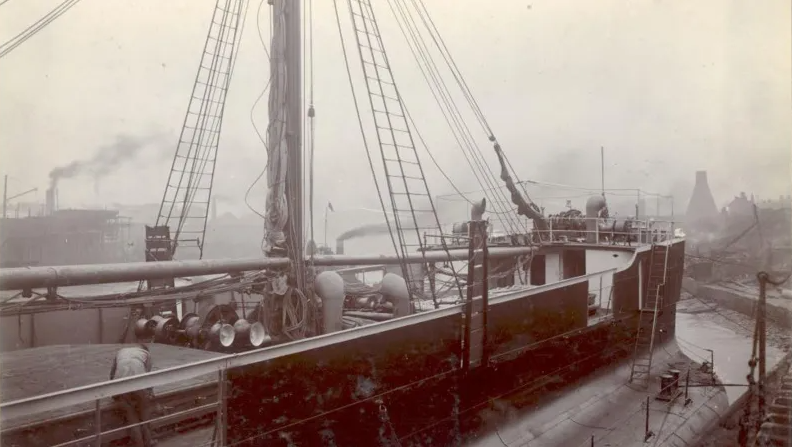While conducting a geological survey in preparation for the construction of a floating wind farm off the coast of Aberdeenshire in north-east Scotland, workers found an "unexpected bonus".
They believe they have found the wreck of a World War I cargo ship in remarkably good condition, 107 years after it was torpedoed during the Great War.
The first of several offshore surveys is set to begin in 2023 to collect geological and geotechnical data to develop a technical ground model for the wind farm, which will be located about 50 miles (80 km) off the coast of Scotland and float in the North Sea.
Called MarramWind, the project is being developed in a partnership between ScottishPower and Shell, with an expected generating capacity of 3GW.

The SS Cheltenham (Tobol), with its distinctive “turret deck”, was found 107 years after it mysteriously disappeared in the North Sea. Photo Sunderland Museums
“It is not uncommon to find shipwrecks when doing work like this, but the ships that have been discovered are usually smaller,” said Colin Anderson, development director at MarramWind.
“This is truly an extraordinary find, as our seabed surveys – which give us vital information about seabed conditions and what that means for the development of MarramWind – have taken us as far as 6,000 miles (9,656 km) away.”
During the survey, MarramWind staff found a shipwreck identified as the Tobol, a 20th-century merchant ship torpedoed by a German U-boat on September 11, 1917. A restricted area was established to protect the site of the discovery and preserve the site.
ScottishPower said data collected from sonar scans carried out during the geophysical and environmental survey for the MarramWind offshore floating wind farm had identified Tobol's likely "final resting place".
Local authorities have been notified of the discovery of the shipwreck, although its identity has yet to be verified or confirmed.
“Although Tobol is known to have been torpedoed during the war, its location remains unclear, so to discover the ship after more than a century and discover its history is something quite special,” said Mr Anderson.
“There is a fascinating story behind the ship, and it would be great if we could learn more about the fate of those on board as information online suggests there were some survivors – although this has not been verified,” said a project representative.
However, he added: "We also need to be aware that the wreck may be the final resting place of the crew members, so hopefully our discovery will help bring closure to the past loss and bring comfort to the families and descendants of the deceased."
Historians say the ship had an extraordinary career: Built in 1901 by a shipyard in Sunderland near Newcastle upon Tyre, a famous shipbuilding site at the time, the Tobol was originally called the SS Cheltenham.
The ship weighed 3,700 tons and was 100 m (328 feet) long. Its defining feature was its distinctive "turret deck" design.
It came under the control of the Russian Navy in 1904 and was renamed Tobol. In 1916, the ship was recorded sailing from Blyth, a port in northern England, to Arkhangelsk, Russia.
“This discovery is a small – but important – piece of a larger maritime heritage puzzle that speaks not only to the global nature of international trade and alliances in the early 20th century, but also to the interconnectedness and competitiveness of national interests at the time – something that remains relevant today,” said Toby Gane, Head of Cultural Heritage and Marine and Coastal Archaeology at consultancy WSP.
“It is incredible that after more than a century, we can finally know where Tobol may have sunk thanks to MarramWind,” the expert said.
Minh Duc (According to Maritime Executive, BBC)
Source: https://www.nguoiduatin.vn/bat-ngo-tim-thay-loi-giai-cho-bi-an-con-tau-dam-tu-the-chien-i-204240915092118195.htm




![[Photo] Russian military power on display at parade celebrating 80 years of victory over fascism](https://vphoto.vietnam.vn/thumb/1200x675/vietnam/resource/IMAGE/2025/5/9/ce054c3a71b74b1da3be310973aebcfd)
![[Photo] General Secretary To Lam and international leaders attend the parade celebrating the 80th anniversary of the victory over fascism in Russia](https://vphoto.vietnam.vn/thumb/1200x675/vietnam/resource/IMAGE/2025/5/9/4ec77ed7629a45c79d6e8aa952f20dd3)
![[Photo] Prime Minister Pham Minh Chinh chairs a special Government meeting on the arrangement of administrative units at all levels.](https://vphoto.vietnam.vn/thumb/1200x675/vietnam/resource/IMAGE/2025/5/9/6a22e6a997424870abfb39817bb9bb6c)
![[Photo] Magical moment of double five-colored clouds on Ba Den mountain on the day of the Buddha's relic procession](https://vphoto.vietnam.vn/thumb/1200x675/vietnam/resource/IMAGE/2025/5/9/7a710556965c413397f9e38ac9708d2f)



























































































Comment (0)